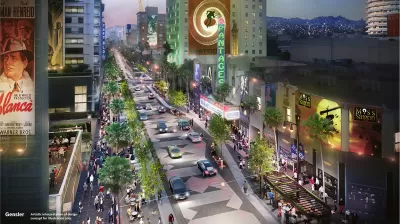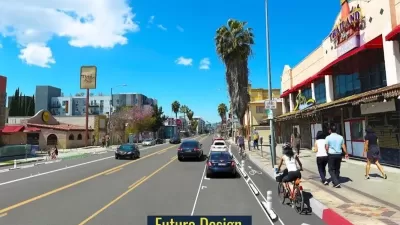A Los Angeles councilmember would drastically redesign one fo the city's most famous streets, stopping short of removing cars entirely from the stretch of road, but still removing vehicle lanes.

Laura J. Nelson and Priscella Vega report on a proposal to totally makeover Hollywood Boulevard in Los Angeles—a popular location for tourists and sight to numerous entertainment industry events, like the Academy Awards.
Los Angeles City Councilman Mitch O’Farrell unveiled a 90-page concept Thursday aimed at creating a less gritty, more welcoming atmosphere for the millions of tourists who visit the Walk of Fame each year.
The initial proposal draws inspiration from world-class streets across the world, including the Avenue des Champs-Elysees in Paris. That could be achieved in Hollywood, too, the plan says, with wider sidewalks, more shade trees, more space for sidewalk dining — and far less space for drivers.
The article also includes the details of the vehicle lanes reduction proposed in the plan:
If approved, the proposal would narrow Hollywood Boulevard to a center turn lane and one travel lane in each direction roughly between La Brea Avenue and Vine Street. The changes would be among the biggest yet for a major street in Los Angeles, where taking space from drivers has sparked outcry.
Eliminating a vehicle travel lane and a parking lane in each direction would create enough space to widen the sidewalks along the Walk of Fame to 25 feet on each side. The city could also add a protected lane for bicyclists and scooters, the proposal said.
As noted in the article, street redesigns that remove vehicles lanes, also known as road diets, have proven controversial and unpopular in Los Angeles. The article provides a lot more information about the outreach effort that will be necessary to effect the proposed changes, and the initials reactions of some of the stakeholders in the area to the idea.
FULL STORY: L.A. considers bold makeover for Hollywood Boulevard: Fewer cars, bike lanes, wider sidewalks

Alabama: Trump Terminates Settlements for Black Communities Harmed By Raw Sewage
Trump deemed the landmark civil rights agreement “illegal DEI and environmental justice policy.”

Planetizen Federal Action Tracker
A weekly monitor of how Trump’s orders and actions are impacting planners and planning in America.

How Atlanta Built 7,000 Housing Units in 3 Years
The city’s comprehensive, neighborhood-focused housing strategy focuses on identifying properties and land that can be repurposed for housing and encouraging development in underserved neighborhoods.

In Both Crashes and Crime, Public Transportation is Far Safer than Driving
Contrary to popular assumptions, public transportation has far lower crash and crime rates than automobile travel. For safer communities, improve and encourage transit travel.

Report: Zoning Reforms Should Complement Nashville’s Ambitious Transit Plan
Without reform, restrictive zoning codes will limit the impact of the city’s planned transit expansion and could exclude some of the residents who depend on transit the most.

Judge Orders Release of Frozen IRA, IIJA Funding
The decision is a victory for environmental groups who charged that freezing funds for critical infrastructure and disaster response programs caused “real and irreparable harm” to communities.
Urban Design for Planners 1: Software Tools
This six-course series explores essential urban design concepts using open source software and equips planners with the tools they need to participate fully in the urban design process.
Planning for Universal Design
Learn the tools for implementing Universal Design in planning regulations.
Caltrans
Smith Gee Studio
Institute for Housing and Urban Development Studies (IHS)
City of Grandview
Harvard GSD Executive Education
Toledo-Lucas County Plan Commissions
Salt Lake City
NYU Wagner Graduate School of Public Service





























